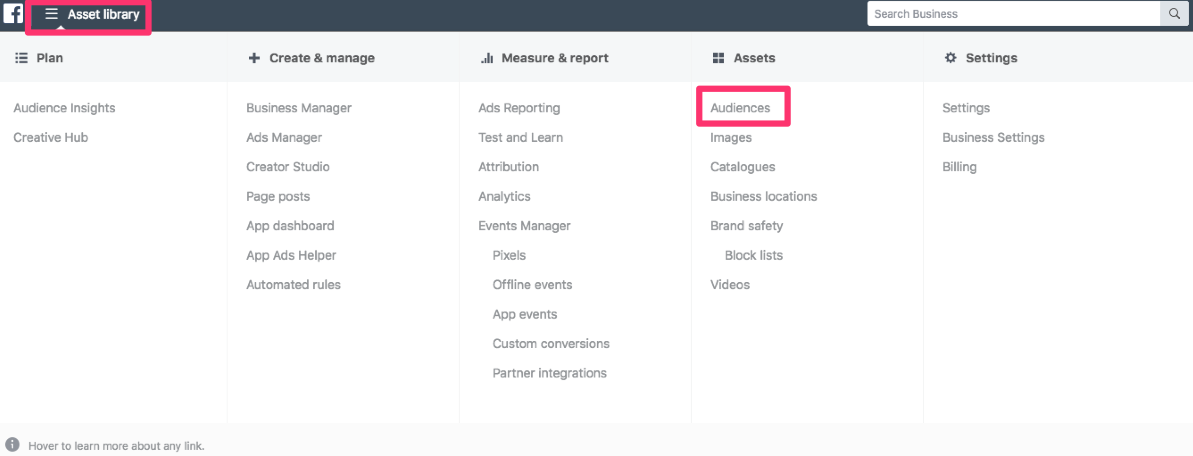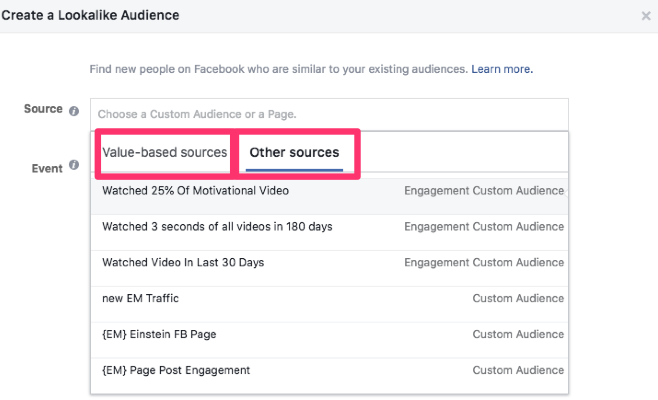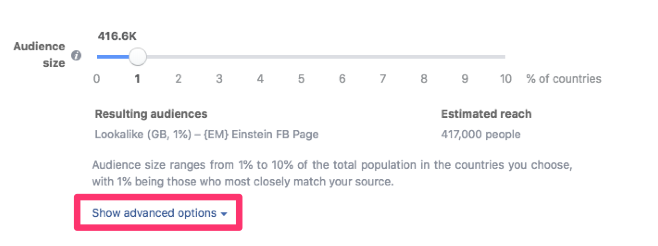It’s time for the final instalment of our Ultimate Guide to Facebook Audiences…
…and we’re ending it in the perfect place, with Facebook Lookalike Audiences.
Before we get into this, I need to do some housekeeping: if you’re new to Facebook advertising and audience building, you won’t get anything out of this guide if you haven’t already learnt about ‘saved’ and ‘custom’ audiences.
So, make sure you’ve read, understood and tested a few audiences from one of our earlier guides to Facebook Audiences:
Everyone ready? Let’s go…
Contents
Scaling
The best place to start this guide is with the Lookalike Audience’s raison d’etre (reason for existence).
When you create a winning saved or custom audience and you start making a high return on your Facebook ads, the first thing you’ll want to do is increase your spend to further boost your profit.
There are several ways to do this:
- Vertical scaling: increasing your budget on your winning ad. This means that you effectively pay Facebook more to show your ad to more people. In theory this sounds amazing, but in practice it’s a very risky game. Vertically scaling an ad should be done gradually and very carefully. Example: increasing an ad spending £100 per day, to £120.
- Horizontal scaling: duplicating your winning ad and running the duplicates on the same budget. This is an effective technique for scaling up your ads, but has its limitations, especially if you have a small audience. Example: duplicating an ad spending £20 per day 5x, creating 6 ads all spending £20 per day, with a total ad spend of £120.
- Lookalike audiences: use the third type of audience to effectively scale your ads without limitations.
What are Lookalike Audiences?
Lookalike audiences are an audience (you can advertise to) who are similar to an audience you have already created. Facebook uses data to match people to your existing audience, by their behaviour, engagement and interests.
They are made on a sliding scale from 1-10%, with the top 1% (in your chosen geo location) being the most similar and 10% being the least. As you’d imagine, the higher you set your audience matching % (e.g. 8,9 or 10%), the larger the audience becomes.
You will only be able to use Lookalike Audiences if you have already created a custom audience or installed a Facebook pixel on your website (you can find out more about either of these steps in Part 2 of our audiences guide). This is because Facebook needs data in order to build out lookalikes.
If you’re completely new to Facebook audiences, your route to building a lookalike audience will look something like this:
- Place a pixel on your website.
- Create a ‘Saved Audience’ based on the interests, behaviours and demographics of your target audience.
- Use the data collected by your pixel to build out Custom audiences.
- Analyse the success of your custom audiences and ads.
- Pick out the best performing and create lookalikes.
Advantages
The best reason to create a Facebook lookalike audience is to scale a winning campaign.
Reaching the right people at the right time is half the battle for an advertiser. An audience who take your desired action (e.g. buy, register, subscribe, engage) are invaluable, so building out lookalikes of these people gives you the opportunity to reach more people, over a longer period of time.
There are two other ways to scale your campaigns (vertical and horizontal) but both have their own drawbacks, whereas a lookalike audience allows you to start afresh and begin testing with any budget.
Lookalike audiences are Facebook’s biggest gift to advertisers (in my opinion). When you’re winning, make sure you take advantage of them!
How to Build a Facebook Lookalike Audience
Just like Part 1 and 2, I’m going to walk you through the entire audience building process. (This should be much quicker than the other two though!)
You’ll need to start by logging into Facebook Business Manager, clicking on ‘Asset Library’ and finding the ‘Audiences’ option:
Click on the blue ‘Create Audience’ tab and select the ‘Lookalike Audience’ option:
This will open a pop-up window, that you’ll use to build your Facebook lookalike audience:
Source
The first option you’ll need to select is the source for your lookalike audience, this is either the Pixel data from your website or one of your custom audiences.
Click on the text box and Facebook will present you with your available options. These will be split into two categories:
- Value-based sources: this is either your website pixel, or data from an app (that you’ve synced with your Facebook Business Manager)
- Other sources: these are the audiences available for creating lookalikes from.
If you are selecting an audience from ‘Other sources’ you won’t be presented with any additional options, but if you decide to go with your pixel data using the ‘Value-based sources’ option, you will be offered the chance to further refine your lookalike audience by ‘Event’…
..Facebook recommends creating lookalikes from people who have made purchases on your website, but you can also choose to ‘Select events with value’, this includes options like add to cart, lead, search, view content, initiate checkout.
These options are all very valuable, but if you’ve followed my guide to Custom Audiences and refined your retargeting audiences at this stage (I definitely recommend doing it this way), you’ll simply need to select this custom audience in the ‘Other sources’ tab, allowing you to skip the ‘Events’ stage.
Location
Location is super-important to almost every Facebook advertiser. Unless you’re purely aiming for engagement (and don’t care where you’re receiving it from) you’ll want to refine your lookalike audience by their location.
Unlike your ‘Saved audience’ location targeting, you cannot choose to select an area smaller than a country e.g. France. However, if you’re building a lookalike audience from a custom audience, and the majority of those people are all located in a particular county/city, Facebook will use this information when building out the new audience.
After you have selected location(s), you’ll see your audience size for the first time:
Audience Size
The final piece of your lookalike audience puzzle is the sliding ‘Audience size’ option. This is the % similarity that you’d like your new audience to be with your original data.
The lower the number you select, the more similar the new audience will be. However, this doesn’t necessarily guarantee that your new audience will make a better return (on your desired outcome).
It’s important to remember that the higher the number you select in your audience size slider, the larger the audience will be. In my example, the difference in size between 1 and 10 is 3.8 million people.
The size of your audience can make a massive difference (as I’m sure many of you will already know) so…
…the best thing to do here is test out a variety of audience sizes. This will depend on the size of your budget, but I’d start out with 3 (or more if the budget allows it), at a variety of points on this scale e.g. 1, 4, 8, or 2, 5, 10.
One way of doing this is to click on the blue text ‘Show advanced options’ which is at the very bottom of the lookalike audience menu:
When this is selected, you will be able to create 1-6 audiences. These audiences represent every point that is between them on the sliding scale. For example, if I was to make one audience between the points of 3 and 7, it would include every percentage between these (3, 4, 5, 6 and 7%):
Remember, the only way you can guarantee success in digital advertising is if you’re prepared to test, drop the losers and scale the winners. Test wherever possible and keep a close eye on the split-test results!
And that’s it! When you’re ready, hit the Create Audience button in the bottom right hand corner:
Conclusion
You might’ve noticed that building out Lookalike Audiences is incredibly simple and straightforward in comparison to its ‘Saved’ and ‘Custom’ siblings…
…but this is the last step in your Facebook audience building journey. There are a lot of steps, tests and lessons to learn before you reach this stage.
The better your saved audiences perform, the more data you’ll be able to utilise when building your custom audiences and the better these custom audiences perform, the more value you’ll be able to generate from your lookalike audiences.
This is a three step process that takes time and skill to perfect, but if you’re willing to put in the effort, you can level-up your brand, business or career with Facebook ads.
What are your experiences with lookalikes? Is there anything I’ve missed?
If you’d like to take your next step into the world of Facebook advertising, check out:
- The Ultimate Guide to Facebook Ad Campaign Objectives
- Our Complete (Step-by-Step) Guide to WINNING Facebook Ad Creatives and Copy.
- How to Create Winning Facebook Ads (from Start to Finish)
- Author Details


















4 Responses
Facebook Insights; most liked, shared and commented posts, the percentage of men and women following your page, the city and country where your fans are located, the most popular hours and days to publish content. offers simple statistics such as our service. In this way, you can decide what kind of content you need to share on your Facebook pages and you can determine the best time and day.
Hey Yilmaz,
You’re right, Facebook Insights are a great way of discovering more about your current audience and what kind of content they like!
Hi, i am local auto expertize, i have a company and i use facebook effectively but in my country nobody interest auto expertize facebook pages. I use facebook ads but return rates so low. What must i do for good results.
Hi Mehmet, what do you mean when you say ‘local auto expertize’? Do you sell cars? Repair them? I’m happy to help when i know more about what the business does…